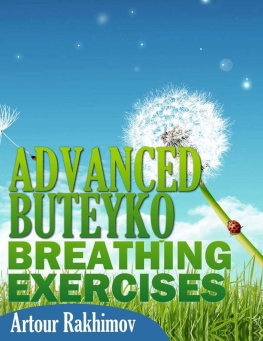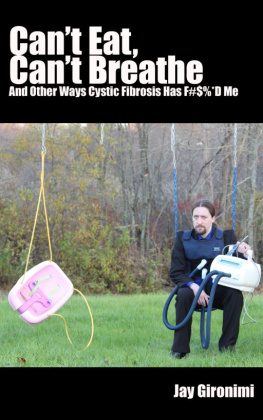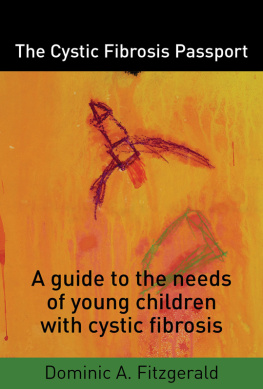Cystic Fibrosis
Reversed
Artour Rakhimov
Copyright 2013 Artour Rakhimov.
All rights reserved.
This book is copyrighted. It is prohibited to copy, lend, adapt, electronically transmit, or transmit by any other means or methods without prior written approval from the author. However, the book may be borrowed by family members.
Disclaimer
The content provided herein is for information purposes only and not intended to diagnose, treat, cure or prevent cystic fibrosis or any other chronic disease. Always consult your doctor or health care provider before making any medical decisions). The information herein is the sole opinion of Dr. Artour Rakhimov and does not constitute medical advice. These statements have not been evaluated by Ontario Ministry of Health. Although every effort has been made to ensure the accuracy of the information herein, Dr. Artour Rakhimov accepts no responsibility or liability and makes no claims, promises, or guarantees about the accuracy, completeness, or adequacy of the information provided herein and expressly disclaims any liability for errors and omissions herein.
Table of contents
Preface
In this groundbreaking book on cystic fibrosis, Dr. Artour Rakhimov analyzes dozens of western medical research studies related to causes of cystic fibrosis, effects of low body oxygen content on the human body, breathing parameters in people with cystic fibrosis, oxygen transport in people with cystic fibrosis, and successful clinical experience of Soviet and Russian medical doctors in dealing with cystic fibrosis.
Dr. Artour Rakhimov provides a blueprint and his own fascinating experience related to successful elimination of major symptoms of cystic fibrosis in his students using natural self-oxygenation methods based on breathing normalization or breathing in accordance with medical norms.
This medical program is largely developed by Russian and Soviet Buteyko breathing doctors, and it is based on a simple DIY body oxygen test. The suggested therapies address all those lifestyle factors that influence body oxygenation and suggest breathing exercises that increase body oxygenation.
Introduction: hypoxia, cystic fibrosis, and chronic diseases

All chronic pain, suffering and diseases are caused from a lack of oxygen at the cell level."
Professor AC Guyton, MD, Textbook of Medical Physiology*
* Worlds most widely used medical textbook of any kind
* World's best-selling physiology book
With the advance of any chronic disease, cystic fibrosis included, oxygen content in body and brain cells progressively decreases. Sometimes low cellular oxygen content is the proven driving force of major symptoms and features of diseases (e.g., as in cases of cancer, asthma, bronchitis, and heart disease). For other conditions, tissue hypoxia or low body O2 is an acknowledged accompanying factor. Indeed, for advanced stages of many chronic diseases, cell oxygenation becomes so low that providing pure oxygen is a common mainstream medical treatment to prolong ones life. CF (cystic fibrosis) is no exception.
1. Hypoxia controls cystic fibrosis transmembrane conductance regulator (CFTR)

As we learned above, hyperventilation and resultant cell hypoxia are normal in people with CF. Tissue hypoxia leads to overexpression of hypoxia inducible factor-1 (HIF-1), an oxygen-sensitive transcriptional activator, which plays a crucial role in cellular adaptation to reduced oxygen availability. Microbiological studies suggest that HIF-1 (representing oxygen availability) controls the expression of cystic fibrosis transmembrane conductance regulator (CFTR). This conclusion was found in the following articles.
American scientists from the Department of Medicine at the University of Alabama (Birmingham) tested the effects of cell oxygenation on CFTR in vitro. The title of their article in the American Journal of Physiology and Cell Physiology , states that Improved oxygenation promotes CFTR maturation and trafficking in MDCK monolayers (Bebk et al, 2001). In their abstract, the researchers wrote, " Together, our data indicate that improved cellular oxygenation can increase endogenous CFTR maturation and/or trafficking ".
Another group of US scientists from Alabama (Department of Genetics, Fleming James Cystic Fibrosis Research Center, University of Alabama at Birmingham) was concerned about the Role of oxygen availability in CFTR expression and function (Guimbellot et al, 2008). Their abstract suggests, " ... In the present study, we investigated regulation of CFTR mRNA during oxygen restriction, examined effects of hypoxic signaling on chloride transport across cell monolayers, and related these findings to a possible role in the pathogenesis of chronic hypoxic lung disease. CFTR mRNA, protein, and function were robustly and reversibly altered in human cells in relation to hypoxia. In mice subjected to low oxygen in vivo, CFTR mRNA expression in airways, gastrointestinal tissues, and liver was repressed. CFTR mRNA expression was also diminished in pulmonary tissues taken from hypoxemic subjects at the time of lung transplantation. Environmental factors that induce hypoxic signaling regulate CFTR mRNA and epithelial Cl(-) transport in vitro and in vivo. "

One year later, in 2009, German scientists from the Hanover Medical High School also supported the idea that Hypoxia inducible factor-1 (HIF-1)-mediated repression of cystic fibrosis transmembrane conductance regulator (CFTR) in the intestinal epithelium (Zheng et al, 2009). They wrote, " ... Consequently, HIF-1 overexpressing cells exhibited significantly reduced transport capacity in colorimetric Cl(-) efflux studies, altered short circuit measurements, and changes in transepithelial fluid movement. Whole-body hypoxia in wild-type mice resulted in significantly reduced small intestinal fluid and HCO(3)(-) secretory responses to forskolin. Experiments performed in Cftr(-/-) and Nkcc1(-/-) mice underlined the role of altered CFTR expression for these functional changes, and work in conditional HIF-1 mutant mice verified HIF-1-dependent CFTR regulation in vivo. In summary, our study clarifies CFTR regulation and introduces the concept of a HIF-1-orchestrated response designed to regulate ion and fluid movement across hypoxic intestinal epithelia ".
Therefore, we can now state that reduced oxygen availability in body cells plays the central role in abnormal work of the CFTR protein that causes formation of salty viscous mucus (due to abnormal transport of chloride and sodium ions and water caused by the CFTR mutation protein). This leads to the development and pathogenesis of CF, where dysfunctional mucus harbors pathogens and promotes respiratory infections and pathological gastrointestinal flora.
Conclusions. Abnormal work of ionic pumps that took place in people with developing cystic fibrosis can take place only due to low oxygen levels in tissues. While all people experience more problems with these tiny pumps to transport sodium, chloride and other ions, people with cystic fibrosis have an additional genetic component that worsens transfer of ions across the epithelial layers in the lungs and GI tract.
Next page












